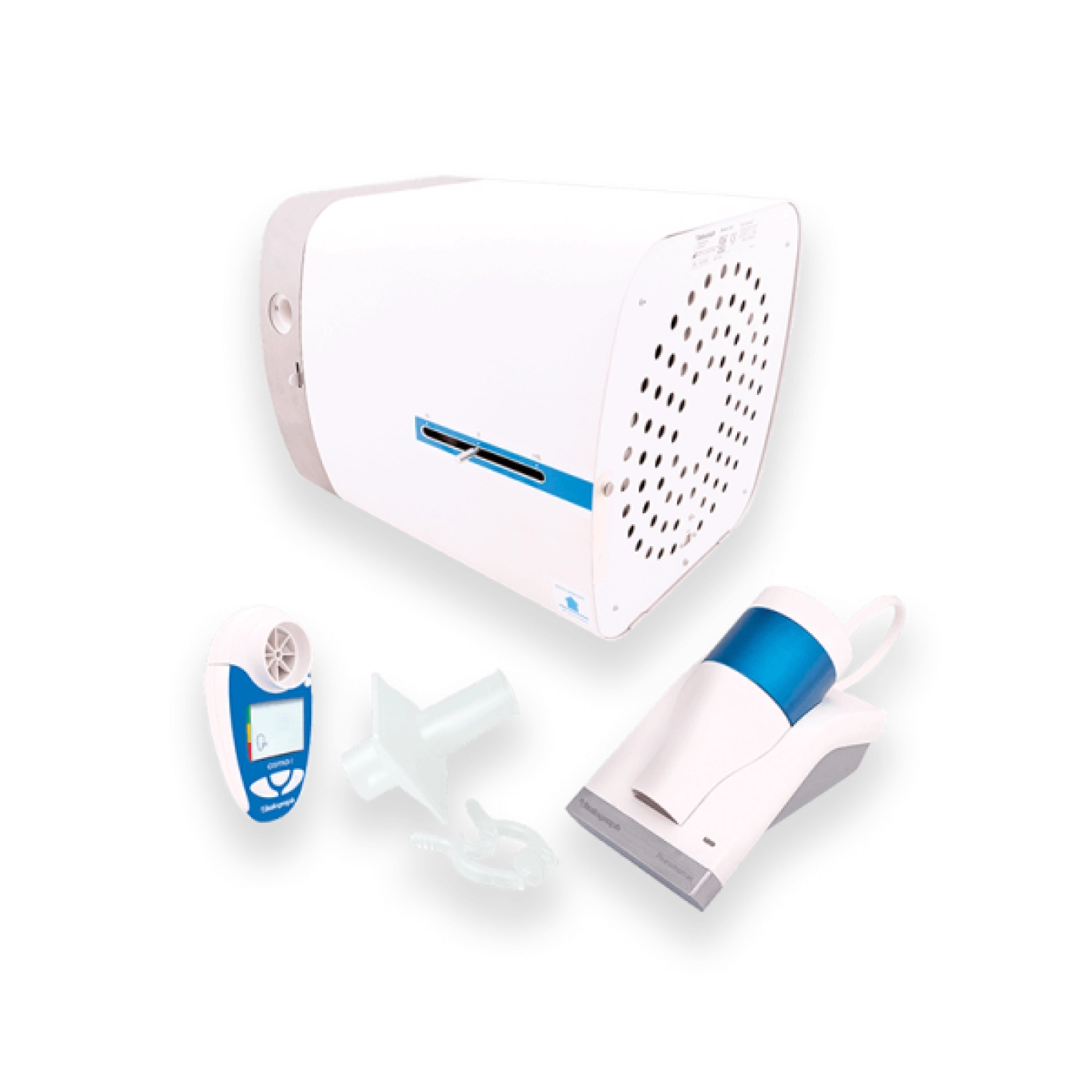Types of Spirometer
and their Technologies
In its simplest form, spirometry is the measurement of how much air a person can breathe out in one forced breath, known as forced expiratory vital capacity (FVC). Different parameters can be measured from the flows that occur during the FVC maneuver. Healthcare professionals interpret volume and flow data alongside graphs showing volume/time and flow/volume to assess lung health.
Vitalograph has investigated many different precision technologies for measuring flows and volumes. Today, the preferred technology used in Vitalograph diagnostic spirometers for flow measurement is the Fleisch Pneumotachograph, and for volume measurement is the Rolling Seal. We use Lilly-type screen pneumotachographs in our lab spirometers and stator-rotor flow measuring technology in our monitoring and screening devices.

Fleisch Pneumotachograph
Vitalograph flow-measuring spirometers feature a Fleisch Pneumotachograph which is an established technology, developed by Professor Alfred Fleisch in Lausanne in 1953.
Fleisch pneumotachograph flow measuring technology is the most accurate, precise and reliable flow measuring technology. The linear signal is simple to process and the spirometry device is extremely robust as it has no moving parts. Even with a Bacterial Viral Filter (BVF), essential for effective hygiene between the patient and the measuring system, the system flow impedance is low even at high flow rates and well within the requirements of the current spirometer standard ISO26782:2009. Fleisch flowmeters may be heated or unheated, but in office spirometry flowmeters are generally unheated for safety, speed of use and accuracy. Vitalograph spirometers use an unheated Fleisch Pneumotachograph.
View our range of Fleisch flow technology spirometers.
A Fleisch Pneumotachograph consists of a bundle of small capillary tubes which create pseudo-laminar flow. The result of this is a linear output pressure signal created by increasing air flow. Two annular rings of pressure measuring points in the Fleisch are ported out to an extremely low range differential pressure transducer, operating in the linear range of the transducer. The differential pressure is sampled by the associated electronics at a frequency of at least 100Hz and 14 bits to allow the instantaneous and accurate calculation of flow rates and, by differentiation over time, the accumulated volume. The turndown ratio of such a device is a staggering 20:1, which allows accurate measurement of very low flows as well as being capable of measuring very high flows.
Easy to use with no cables or arms, no moving parts.
Extremely robust, designed to withstand being frequently dropped.
Accurate, linear and stable.
Precise even at very low flows.
Reliable with consistent results.
Low flow impedance, even with BVF (well within standard).
Simple, hygienic system using BVFs.
Easy to clean.
Can be easily checked for accuracy (using a Precision Syringe).
Meets ISO 26782:2009 spirometry standard & ISO 23747:2007.
Fulfils all ATS/ERS 2019 spirometer guidelines.
Stator-Rotor
Vitalograph monitoring and screening devices use stator-rotor flow measuring technology. These lightweight handheld devices have a limited lifespan compared to spirometers and are ideally suited to home monitoring or for respiratory screening.
Small and lightweight, the simple digital signal produced by the spin of the rotor provides accurate results for monitoring and screening of respiratory parameters such as PEF, FEV1 and FEV6. On Vitalograph devices, a simple LCD screen provides immediate results and the device stores several hundred tests that can be downloaded to view trends in patient data. This spirometric measuring technology is often referred to as a ‘turbine’, although a true turbine has a curved blade and requires no stator.
View our range of monitors and screeners which use this technology.
In a stator-rotor system, a multi-vaned stator induces swirl on the airflow which makes a flat blade (the rotor) spin. The rotor interrupts a light source as it spins, and a detector measures the air flow by counting the revolutions. The rotor rotates at a speed that is approximately proportional to flow. Devices are calibrated at the time of production.
Stator-rotor and turbine based systems are not a suitable technology for measuring very low flows because of the effect of inertia on the spin of the rotor, making it unsuitable for full spirometry. Rather than risking inaccurate FVC readings, Vitalograph devices use a proven surrogate measure, FEV61 ,2, in our low cost monitoring and screening devices that use stator rotor flow measuring technology.
1 Bellia V, Sorino C, Catalano F, et al Validation of FEV6 in the elderly: correlates of performance and repeatability Thorax 2008;63:60-66.
2 M. Akpinar-Elci, K. B. Fedan, P. L. Enright FEV6 as a surrogate for FVC in detecting airways obstruction and restriction in the workplace European Respiratory Journal Feb 2006, 27 (2) 374-377.
Easy to use.
Small, lightweight and compact.
Cost effective.
Rapid testing for screening and epidemiology.
FEV6 is an acceptable surrogate for FVC.
Can be checked for accuracy.
Meets ISO 26782:2009 spirometry standard for FEV1.
Meets ISO 23747:2007 for PEF.
Flow impedance of Vitalograph devices meets recognized standards (unusual for this technology)
Rolling Seal
Vitalograph volume-measuring spirometers feature rolling seal technology, measuring up to 12L. Rolling seal technology measures true volume displacement, thereby providing the highest level of accuracy for volume measurements.
Direct determination of volume has the advantage of being absolute and measured at ambient conditions during both inspiration and expiration. This high accuracy makes the rolling seal well suited to routine clinical testing, research and as an accuracy reference for other non-volumetric spirometers. Volumetric devices are also ideal for training where direct determination of volume provides a clear platform for demonstration and explanation of technique and results.
Launching soon! The Gold Standard, our new rolling seal spirometer, Talk to us to learn more.
A lightweight piston is mounted horizontally in a cylinder and a rod that rests on frictionless bearings supports the piston which is attached to the cylinder wall by a flexible plastic seal. When the test subject completes a spirometry blow, the piston moves by rolling the seal onto itself rather than sliding, in direct proportion to the volume of exhaled air. The large diameter piston only requires movement of a few inches to record a large volume change. A highly accurate digital signal is generated via a potentiometer to a PC for viewing and storing data. In order to ensure smooth, accurate flow profiles, Vitalograph have developed an exceptionally low resistance movement in the Gold Standard rolling seal mechanism.
Direct determination of volume.
Highly accurate volumes.
Extremely low resistance.
Easy to use and clean.
Results direct to PC.
Closed system removes risk of aerosolization.
Screen Pneumotachograph (Lilly-type)
Heated Lilly-type screen pneumotachographs are used in lab spirometers where additional test types need to be integrated into the flowhead and the requirement for easy cleaning, servicing and stability through extended periods of testing are of paramount consideration.
Lilly screen pneumotachographs measure flow in a similar way to Fleisch technology, employing a fine wire mesh screen with low resistance to air flow. Flow is calculated by measuring the pressure differential across a screen or series of screens. This type of device is very accurate and stable. A screen pneumotachometer is slim, allowing space in the flowhead for other features e.g. demand valves and other gas inputs and outputs making it suitable for lab spirometry requiring additional gases for tests such as DLCO and nitrogen washout.
The screen used in a Lilly-type Pneumotachograph is very easy to clean and service. The heated screen provides stable measurement for protracted periods of testing, although the additional electronic components in the flowhead render it less suitable for office spirometry than Fleisch flowhead technology.
Highly accurate.
Stable.
Suitable for clinic use with high patient turnaround.
Suitable for extended test periods.
Suitable for Lab based DLCO testing and nitrogen washout testing.
Easy to clean and service
Compatible with respiratory lab equipment.
Ultrasonic
Ultrasonic technology is used in flow measuring office spirometry systems. Small and lightweight, ultrasonic spirometers measure flow by determining the Doppler effect in both expired and inspired air, using ultrasound. The variation in ultrasonic waves caused by a change in gas velocity is used to give a measure of the average gas velocity between 2 transducers as an analog signal.
While this technology is very sensitive, Vitalograph does not use ultrasonic flow measuring technology as it is prone to errors before measurement with low flow profiling from ambient air movement and does not measure low flows accurately3. Accuracy depends on a developed flow profile that is not found in turbulent expired air, therefore flow rates must take into account the turbulent gas flow profile; in ultrasonic technology this is corrected by software algorithms based on Gaussian probability. Turbulent airflow is overcome in Fleisch, Screen and Stator-Rotor and turbine measuring technology by design elements that manage airflow i.e. the swirl induced by the stator in stator-rotor devices, laminar flow induced by capillaries in the Fleisch and the mesh in Lilly technology.
Hygiene in ultrasonic devices is dependent on expensive disposable flow tubes with additional filters required for infection control.
3 Perera, A., Friedrich, P., & Ledermüller, R. (2018). Novel hot-wire based spirometry is highly accurate at low flow rates, Current Directions in Biomedical Engineering, 4(1), 513-515.
In an ultrasonic flow meter, the distance that an ultrasonic pulse has to travel between transducers is known, as is the time taken for the pulse to move between transducers with no gas flow at known temperature, pressure and humidity. Changes in gas flow create measurable changes in the time taken for the ultrasonic pulses to travel between transducers and this difference creates an analog signal that can be measured to calculate gas flow rate through the spirometer.
The time taken for the ultrasonic pulse to move between transducers is affected by temperature, humidity and ambient flows which requires these factors to be measured and correction algorithms applied.
Hot Wire Anemometer
In spirometers using hot wire anemometer flow measuring technology, the measuring principle is based on the change of resistance in a heated wire as heat is transferred to gas flowing past it.
Hot wire measuring technology is used in lab spirometer systems as it is capable of measuring flow using gases other than room air by applying conversion factors and it can give very stable, accurate measurements. However the requirement for delicate electrical wires within the flowhead means that the technology is unsuited to portable applications and can be unreliable. Vitalograph does not use hot wire measuring technology due to its fragility and the added complexity of patient safety incurred by including electrical parts within the flowhead.
Gas flow past an electrically heated wire element causes a temperature decrease in proportion to the mass of gas and its flow. Due to this, the resistance of the wire also changes. The change in resistance of the wire becomes a measure of flow rate. The flow signal is integrated electronically or by software to obtain a volume measurement.
Legacy and Research Spirometer Technology
Wedge Bellows
Vitalograph is probably best known for its iconic wedge bellows spirometers which were produced from 1962 with the last examples of such devices sold in the early 2000s. Many of these devices are still in use in research and teaching establishments, indicating the robustness and high quality build that Vitalograph devices espouse.
Water Seal
Water seal spirometers are rarely used today as they are large and heavy, difficult to move, provide a potential source of contamination from water spills, and it is difficult to keep the device clean. However they are still sometimes used in teaching and research as, like wedge bellows technology, they provide high accuracy volumes and the direct determination of volumes is clear and simple for demonstration purposes.
Respiratory diagnostics education and disease management
As experts in Respiratory Diagnostics, we are committed to providing our community with the latest in educational material.



